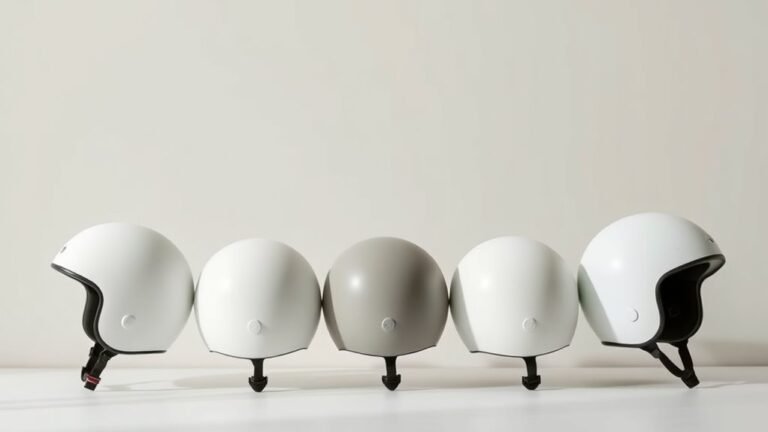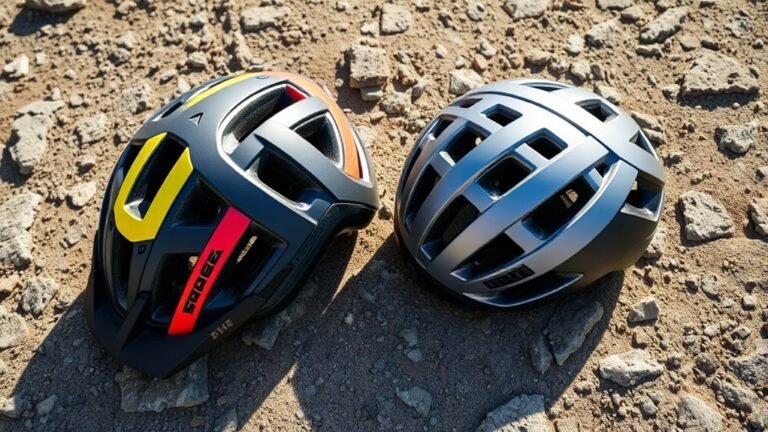How to Prevent Helmet Fogging in Cold Weather
To prevent helmet fogging in cold weather, make sure to choose a helmet with effective ventilation and anti-fog features. Use anti-fog sprays or wipes on your visor to create a moisture barrier. Regularly clean your visor to avoid residue buildup, and adjust ventilation ports to promote airflow. Try to modify your breathing techniques by avoiding direct exhalation into the helmet. For more effective options, consider different technologies and strategies that enhance your riding experience.
Understanding the Causes of Helmet Fogging

When you wear a helmet, fogging often occurs due to the difference in temperature between the inside of the helmet and the outside environment. This temperature disparity creates conditions ripe for fog formation, especially in colder weather. When you exhale, the warm, moist air mixes with the cooler interior of the helmet, leading to condensation. Higher humidity levels exacerbate this issue, causing more moisture in the air, which can quickly turn to fog. To enjoy your ride without the obscured view, it’s essential to understand these causes. By managing temperature and humidity, you can reduce fogging. Awareness of these factors helps you maintain clarity, ensuring your freedom on the road isn’t hindered by impaired vision.
Choose the Right Helmet

Choosing the right helmet is essential for minimizing fogging. Look for models with effective ventilation systems that promote airflow, as well as options featuring anti-fog liners that reduce moisture buildup. These features can greatly enhance your visibility and overall riding experience.
Ventilation System Features
A helmet’s ventilation system plays an essential role in preventing fogging, ensuring you maintain clear visibility during your ride. When choosing a helmet, consider various ventilation types, such as fixed vents, adjustable vents, and exhaust ports. These features enable effective airflow management by allowing fresh air to circulate while expelling warm, humid air. Look for helmets with strategically placed vents that promote ideal airflow without compromising safety. A good ventilation system not only reduces fogging but also enhances comfort, helping you enjoy the ride without distractions. Remember, the right helmet can make a significant difference in your overall experience, so prioritize ventilation features to keep your vision clear and your spirit free on the road.
Anti-Fog Liner Options
While many helmets come equipped with basic features to reduce fogging, opting for one with an anti-fog liner can greatly enhance your experience. These liners are specially designed to minimize moisture accumulation, keeping your vision clear. When choosing a helmet, look for options that include fog-resistant inserts, as they provide a more effective barrier against fogging compared to standard liners. Additionally, consider incorporating anti-fog sprays for an extra layer of protection. These sprays can enhance the performance of your helmet’s liner, ensuring you have a fog-free ride. Remember, a well-chosen helmet with the right anti-fog features not only improves visibility but also contributes to your overall freedom and enjoyment while maneuvering through cold weather conditions.
Use Anti-Fog Products

When it comes to preventing helmet fogging, using anti-fog products can greatly enhance your visibility and safety. You’ve got options like anti-fog sprays and anti-fog wipes, which are specifically designed to reduce fog buildup on your helmet’s visor. Anti-fog sprays create a thin, invisible barrier that helps moisture disperse evenly, while wipes provide a quick and convenient application, perfect for on-the-go use. Make certain to follow the instructions for application to maximize effectiveness. Before your ride, apply these products to guarantee a clear line of sight. Remember, a fog-free helmet isn’t just a comfort; it’s essential for maintaining the freedom and safety you crave while enjoying your adventures. Invest in these products, and keep your vision clear.
Adjust Your Ventilation
Effective ventilation is essential for preventing helmet fogging, as it allows for better airflow and moisture control. To guarantee ideal airflow management, you should regularly make ventilation adjustments based on temperature and activity level. Open vents can greatly enhance airflow, helping to reduce humidity inside your helmet. Conversely, when it’s extremely cold, partially closing vents might be necessary to maintain warmth without sacrificing too much airflow. Remember, every helmet is different; familiarize yourself with your model’s specific ventilation system. Experiment with various vent configurations during rides to find the right balance that keeps you comfortable and fog-free. Ultimately, proper ventilation adjustments empower you to enjoy your ride, embracing the freedom of the open road without the distraction of fogged-up gear.
Keep Your Visor Clean
To effectively prevent helmet fogging, keeping your visor clean is essential. Use anti-fog products to create a barrier against moisture and regularly wipe your visor to remove dust and smudges. A clear visor not only enhances visibility but also reduces the chances of fog buildup.
Use Anti-Fog Products
One of the best ways to combat helmet fogging is by using anti-fog products specifically designed for visors. These products create a protective layer, minimizing condensation and enhancing your freedom on the road. Here are some effective options to take into account:
- Anti-fog sprays: Apply this solution to your visor for long-lasting protection.
- Anti-fog wipes: Convenient and easy to use, these wipes can quickly prepare your visor before a ride.
- Anti-fog films: Adhesive films can be applied to the inside of your visor for consistent clarity.
- Homemade solutions: A mixture of water and dish soap can serve as an affordable alternative.
Regularly Wipe Visor
Regularly wiping your visor is essential for maintaining ideal visibility and preventing fog buildup. A clean visor not only enhances your field of vision but also plays a vital role in fog prevention. Dirt, grime, and moisture can easily accumulate, obstructing your view and increasing the likelihood of fogging. For effective visor maintenance, use a microfiber cloth or an appropriate visor cleaner to gently remove any contaminants. Make it a habit to check and clean your visor before each ride, especially in cold weather. This simple practice empowers you to enjoy the freedom of the open road without the distraction of a foggy visor. Remember, clear vision is key to safe riding, so take the time for proper maintenance.
Modify Your Breathing Techniques
While it may seem simple, modifying your breathing techniques can greatly reduce helmet fogging. By focusing on effective moisture management, you can enjoy your ride without the hassle of obstructed vision. Here are some practical tips:
Modifying your breathing techniques can significantly reduce helmet fogging, enhancing your riding experience with clear vision.
- Breathe through your nose: This helps to warm and humidify the air before it reaches your helmet.
- Control your exhale: Exhale gently and avoid directing your breath toward the visor.
- Lower your chin: Tucking your chin can help redirect your breath downwards, away from the visor.
- Pace your breathing: Slow, deep breaths can minimize the amount of warm air escaping into the helmet.
Implementing these breathing techniques can greatly enhance your riding experience, keeping your vision clear and your freedom intact.
Consider Using a Fog-Free Lens or Insert
Modifying your breathing techniques is a great start, but for even better fog prevention, consider using a fog-free lens or insert. These fog-free options are specifically designed to reduce condensation, allowing you to maintain clear visibility while enjoying your adventures. Many riders appreciate the lens benefits, such as enhanced clarity and extended durability against the elements.
When selecting a fog-free lens, look for anti-fog coatings or inserts made from materials that naturally resist fogging. These lenses often feature ventilation systems that promote airflow, further minimizing moisture build-up. By investing in a quality fog-free lens or insert, you can guarantee that your helmet performs at its best, giving you the freedom to focus on the ride ahead without the distraction of fogged-up vision.
Frequently Asked Questions
Can Wearing a Balaclava Help Reduce Helmet Fogging?
Yes, wearing a balaclava can help reduce helmet fogging. The balaclava benefits include wicking moisture away from your face and providing a barrier against cold air, which helps maintain a more stable temperature inside your helmet. By minimizing the temperature difference between your breath and the helmet’s interior, you’ll enhance fogging prevention. This allows you to enjoy your ride without the distraction of fogged-up visors, giving you the freedom to focus on the road ahead.
Is Helmet Fogging More Common With Full-Face Helmets?
Yes, helmet fogging is more common with full-face helmets. In fact, studies show that around 70% of riders experience fogging in these styles. While full-face advantages include better protection and aerodynamics, they also trap more moisture. Fogging factors like temperature differences and breath condensation amplify this issue. To maintain visibility and freedom on the road, you might want to explore anti-fog treatments or ventilation solutions tailored for your full-face helmet.
How Often Should I Clean My Helmet Visor?
You should clean your helmet visor regularly, ideally after every ride or at least once a week if you’re riding frequently. Proper visor maintenance enhances visibility and safety. Use gentle cleaning techniques, like a microfiber cloth and a suitable visor cleaner, to avoid scratches. Avoid harsh chemicals that can damage the visor’s coating. Keeping your visor clean not only improves your ride but also guarantees a clearer, safer view of the road ahead.
Do Different Weather Conditions Affect Fogging Levels?
Yes, different weather conditions greatly affect fogging levels. Did you know that 70% of fogging occurs when humidity levels rise above 60%? Temperature changes can also play an essential role; as the air cools, it holds less moisture, leading to condensation on your visor. To combat this, you might consider using anti-fog treatments or ensuring proper ventilation, allowing you the freedom to ride comfortably without the hassle of obstructed vision.
Can I Use Homemade Solutions to Prevent Fogging?
Yes, you can use homemade remedies to prevent fogging. Common solutions include using a mixture of dish soap and water or shaving cream, which can create a thin film that reduces condensation. However, their effectiveness comparison to commercial anti-fog products may vary; store-bought options often provide longer-lasting results and better clarity. If you prefer a DIY approach, just remember to test different mixtures to find what works best for your helmet.






